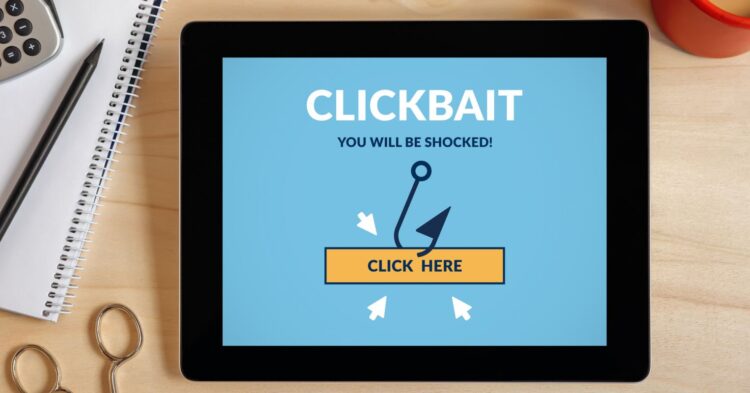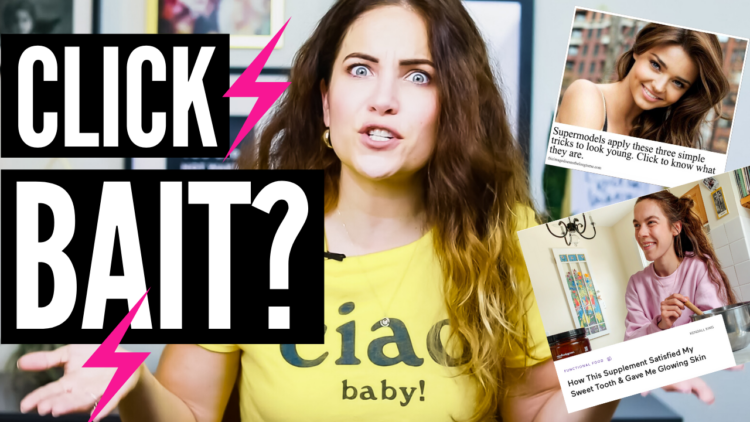
Everyone’s always talking about content. Content marketing, content engagement, content outreach. But what exactly constitutes content? Does it have to be substantial? For most topics you can imagine, a few thousand interns have already written and published articles that are, beyond slight variation in grammar and punctuation, more or less identical. Is this still content? In today’s market, 5% of the digital content that’s produced generates 90% of the engagement. This means that for most businesses, a blog reproducing similar titles to what can already be found on the web isn’t likely to get you more customers. Clickbait, on the other hand, is an easier enterprise. Trend-hopping, gossip-reporting, controversy-stirring — these are all things that get clicks. Is it a worthwhile practice for businesses?

A desensitised public
Individuals that may have been horrified at the title ‘Top 5 botched plastic surgeries’ 10 years ago will now scroll casually past, perhaps even pausing to inspect whether the thumbnail contains something particularly grotesque. We are not impressed by clickbait, but we’re also not shocked by it. On those occasions when we do click through, do we still carry an air of disapproval, appalled to be navigating such depraved locales, but coerced by a particularly juice title even one so dignified could not resist? Or are we more forgiving to the publisher? If the latter is true, then clickbait may well have become a viable business strategy.

Levels of evil
Like Dante’s Inferno, clickbait can be categorised into degrees of offence. Inflammatory celebrity stories, fake political news and 10 secrets your doctor doesn’t want you to know are buried somewhere deep in the lowest reaches. This world of depravity belongs on very specific platforms that cherish such material, having long since abandoned the possibility of a trusting consumer relationship.
But there are lesser evils. Trend-hopping, for example, ranks among the more minor offences, and should be freely indulged by all. Any new topic garnering public interest that week, be it the Meghan Markle debacle, the fuel crisis or a new diet, represents an opportunity to jump into the mix and collect some of that good digital traffic. In years past, this may have been called ‘news’, but today, ‘news’ remains ‘news’ for all of 30 minutes, until it’s been written, rewritten and repeated by 300 publications, at which point blogging newcomers need only plagiarise from the existing selection. Then, it’s trend-hopping, and an opportunity to convert some of that temporary traffic.
Common phrases in the titles of these literary creations include, ‘X will make you’, ‘this is why’, ‘people are freaking out’, ‘will give you goosebumps’, ‘shocked to see’, ‘melt your heart’ and ‘what happened next [will shock you]’. Clickbait is immediate, often discussing what is happening right now and, of course, exaggerated. Buzzfeed uses the tactic religiously, and in March 2024 alone garnered over 1.2bn page views across its various websites. Few blogs and publications should seek to follow in their footsteps, but some lessons can perhaps be drawn about appealing to reader curiosity.

The bait itself
One key factor distinguishing functioning clickbait from bad practice is how the ‘bait’ is dressed up. Titles that offer pure bait with no reward, along the lines of ‘this absolutely mind-boggling thing happened and we are absolutely going to tell you all about it, if you just click onto this link please please and thank you’, are not winning any repeat customers. There is too much anticipation, and we don’t like being treated as children. But, how about incendiary facts in the title? Meghan Markle says X, shocks royal family. Man gets into altercation on New York subway, almost loses his life. This is grey area clickbait. You might be overstating, exaggerating and dramatising the intrigue, but you’re not outright lying and you’re not tempting the reader to ‘find out what happens next…’
This kind of clickbait may be a more viable content marketing strategy than even an average old blog, especially for businesses without a clear topic field to write about. Simply reporting shocking, dramatic new stories (that don’t necessarily have to be negative — animal rescue stories garner huge viewership), could get you clicks without the adverse impact to your image as a business. Ultimately, making high-quality content that people will love to read when you don’t have an area of expertise on which to write is extremely challenging. Ross Pike of Koreti Ltd comments, ‘We are sometimes reluctant to advise our clients to manage a regular blog. Many businesses just want to get involved, thinking the sheer quantity of blogs must equate to easy conversions and sales. Unfortunately, this isn’t always the case.’ Especially in today’s climate of saturated media, it is quite a feat to capture a consumer’s attention for any length of time. People read articles when they’re looking for information, or when something simply catches their eye. Clickbait in its lighter forms is a semi-reliable way of capturing that attention, where the typical business blog might struggle.

Content marketing is supposedly the most lucrative form of marketing in today’s market. But, as many know, and will recall with a wince, you can very easily devote hours and hours of your time to a blog that earns you single-digit customers. Neil Patel and other marketing gurus will say that the mistake these individuals made was in not outlining a clear ‘content marketing strategy’. True enough, blogs with a specific focus are more likely to succeed than their less-defined counterparts. But for people who don’t have valued information and expertise, how do you find your niche? The less egregious forms of clickbait, for some people, may be a solid strategy.







